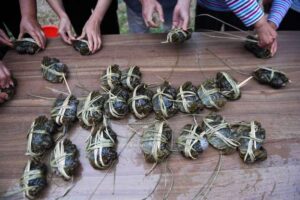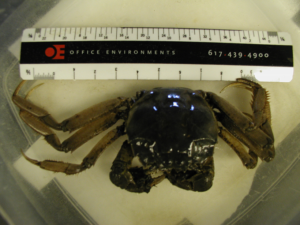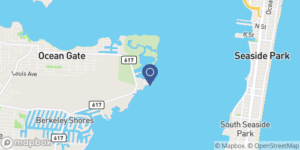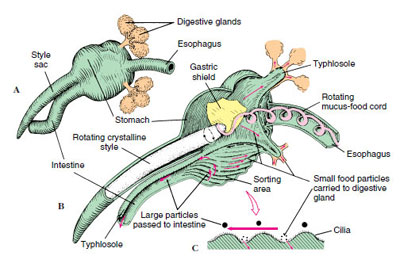
'Operation Hidden Mitten'
In ‘Operation Hidden Mitten,’ U.S. cracks down on smuggling of hairy-clawed crab
When law enforcement agents tore open 50 boxes labeled T-shirts, jeans, tools, and auto parts in Cincinnati and found 3,700 live crabs with hairy claws and a deadly reputation.
Named for their furry claws, mitten crabs are native to Asia, where they’re a delicacy. They’re also listed among the world’s top hundred most invasive species and are banned from importation into many countries, including the United States. Seafood buyers caught smuggling them into the country can face fines and even jail time.
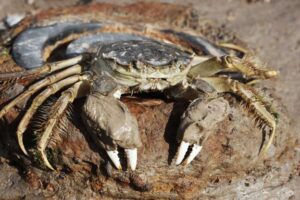 © Photograph by Mike Lane, Minden Pictures
© Photograph by Mike Lane, Minden Pictures
The crabs were being imported by Asian markets and food suppliers to be sold in cities in the United States. The mitten crab, a Chinese delicacy also known as Shanghai hairy crab, is one of the world’s top hundred most invasive species that threaten native wildlife and habitats, making it a major target for officials fighting wildlife crime.
With ravenous appetites, mitten crabs prey on local wildlife, simultaneously upending food chains and fisheries. When they tunnel into the soft mud along riverbanks, they trigger erosion and destabilize levees. They also pose a health threat. When eaten raw or lightly cooked, they can transmit a parasite that attacks human lungs.
“Wildlife laws prohibit mitten crabs, listed as an ‘injurious species,’ from being imported into the U.S.,” says Eva Lara-Figuerdo, a wildlife inspector with the United States Fish and Wildlife Service based in Atlanta, Georgia. “An injurious species is a threat to our native ecosystems, or a potential public health hazard.”
Concerned about the threat of smuggled mitten crabs escaping into the wild in the U.S., authorities are intensifying efforts to intercept crab contraband. “This is a very lucrative market, $11.5 billion a year,” Lara-Figuerdo says. “Transnational crime syndicates are smuggling them in large quantities.”
U.S. wildlife agents and border control authorities launched Operation Hidden Mitten—a nationwide push to interdict crabs headed for Asian markets. Closely monitoring incoming shipments at ports including New York, Miami, San Francisco, Cincinnati, and Los Angeles, authorities have already uncovered hundreds of mislabeled boxes collectively containing nearly 15,000 live crabs. That’s three times the highest number ever snagged before, according to Lara-Figuerdo.
© Photograph by Xu Yu Xinhua, eyevine/Redux
In China, mitten crabs are raised on large aquafarms to meet voracious demand for the popular seafood. When the autumn harvest season begins, villagers participate in timed contests to see who can neatly and tightly tie up the most live mitten crabs. U.S. authorities worry that smuggled live crabs, similarly bound and packed in boxes, might escape into the wild and multiply to the detriment of local wildlife and habitats.
“When you see the number of boxes coming in, that was really eye opening,” she says. “We’re looking to take down these transnational crime syndicates smuggling crabs. If the crabs were to escape into the wild and multiply, the implications would be profound.”
It’s already happening, scientists say. Mitten crabs likely transported in ships’ ballast water or possibly intentionally released to create a local source for seafood markets are beginning to get a claw-hold in U.S. bays and rivers.
“They’re shipped live, and they can be out of water for a long time,” says Darrick Sparks, a biologist with Smithsonian’s Environmental Research Center, in Edgewater, Maryland, which runs Mitten Crab Watch, a website where citizens can report sightings. The crabs can travel by water and land up to 11 miles a day, Sparks says—nearly the length of Manhattan.
 © Photograph by U.S. Fish and Wildlife Service
© Photograph by U.S. Fish and Wildlife Service
Operation Hidden Mitten, a joint investigation by the U.S. Fish and Wildlife Service and Customs and Border Protection, seized nearly 15,000 live Chinese mitten crabs at multiple ports last fall. Seafood smugglers had falsely declared the shipments as t-shirts, jeans, auto parts, and other commercial goods.
“If a load made it into the country and fell off the truck into the water, you could suddenly have a large population,” Sparks says. “A single female can carry a million eggs. You only need a few to find each other and start reproducing.”
About the size of a hamburger patty with long legs and furry, white-tipped claws, mitten crabs are native to the coast of China and Korea. Juvenile crabs migrate from saltwater estuaries up rivers and tributaries, where they spend two to five years burrowing along riverbanks and feeding on freshwater fish and invertebrates. Eventually, they scuttle back into saltwater to breed.
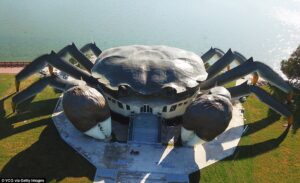 Like Thanksgiving turkey in the America, mitten crab is central to China’s autumn celebrations, when the crustaceans are in peak season. Aquaculture farms, located mainly in the Yangtze River delta, help meet the voracious demand. People pick the steamed crabs apart by hand, carefully separating the tender edible meat from the guts and dipping it in a light sauce of minced ginger and vinegar.
Like Thanksgiving turkey in the America, mitten crab is central to China’s autumn celebrations, when the crustaceans are in peak season. Aquaculture farms, located mainly in the Yangtze River delta, help meet the voracious demand. People pick the steamed crabs apart by hand, carefully separating the tender edible meat from the guts and dipping it in a light sauce of minced ginger and vinegar.
 Mitten crabs are so favored in China that a giant hairy crab-shaped museum was built recently on the shore of Yangcheng Lake, in the eastern city of Suzhou, considered home of the tastiest crabs.
Mitten crabs are so favored in China that a giant hairy crab-shaped museum was built recently on the shore of Yangcheng Lake, in the eastern city of Suzhou, considered home of the tastiest crabs.
Live mitten crabs have even been sold from refrigerated vending machines, as on a street in Hangzhou, the capital of Zhejiang province, and inside a nearby subway station—for about three dollars each, including crab vinegar and two bags of ginger tea. In the U.S., where live mitten crabs are forbidden, consumers pay up to $50 for a black-market crab.
Pariahs in Europe
The first records of mitten crabs in Europe date back to 1912 in Germany, when scientists believe they came from Asia in ballast water. During the mid-1930s, trappers enlisted to help remove mitten crabs from Germany’s waterways hauled out 580,000 pounds in one year. Some trapping sites yielded more than 100,000 in a single day. They had become a formidable pest, devouring the local aquatic wildlife, weakening riverbanks, and ensnaring fishing gear.
In England, mitten crabs have so inundated the River Thames that officials are mulling whether to start a fishery to sell them back to China, and local wildlife activists are launching campaigns to promote eating them. After fishing for mitten crabs in the Thames, TV chef Gordon Ramsay expressed his support for gastronomic control. “They’re much sweeter and more intense than other crabs,” Ramsey said, cooking alongside the head chef at London’s Royal China Club during season five of his show The F Word. Stir-fried with ginger and tofu: “Bloody hell,” he groaned. “My God, they’re delicious.”
Lara-Figuerdo says she would tread lightly on encouraging people in the U.S. to eat the invasive crabs. “If you came up with a campaign to harvest crabs already here, that would be beneficial,” she says, similar to how divers hunting introduced lionfish off Florida’s coast are selling them to restaurants, helping to control the wild population. However, she says, “you have to hold strong on prohibiting the importation of live crabs.”
In the U.S., where the fight against invasive species costs the federal government $120 billion a year, mitten crabs were first spotted in San Francisco Bay during the late 1980s. The population boomed for a while, then mysteriously tapered off, says the Smithsonian’s Darrick Sparks. “It might have been a change in the water salinity, or maybe a predator upriver eating them—birds, raccoons, or fish,” he says. “No one really knows. But their populations do cycle, even in their native environment. We could suddenly see a large population show up again.”
The first report of mitten crabs on the East Coast came in 2015, when a fisherman tending his crab traps in the Chesapeake Bay found a sizable, hairy-clawed crustacean in the mix.
“We started reaching out to fishing communities to see if other people were seeing them, and doing public education so people would report their sightings,” Sparks says. “One crab was walking along the dock in Baltimore’s Inner Harbor!”
Smithsonian’s online tracking map is now peppered with sightings in the Chesapeake Bay, Delaware Bay, and along New York’s Hudson River, as far as a hundred miles upstream. “We believe that there’s an established population in the Hudson,” Sparks says. “We don’t believe their numbers are extremely high, but there’s a lot of water for them to hide in. If it got to the numbers in Germany, it could be a big impact on the environment.”
George Jackman, a former New York City police lieutenant who is now the senior habitat restoration manager for Riverkeeper, a Hudson River conservation organization, says he’s concerned about a mitten crab incursion. But he also has faith in local wildlife. “I believe our sturgeon and striped bass will give them a rousing New York welcome,” he says. “Our predators are on the front lines of this invasion.”
Since U.S. states aren’t actively surveying for mitten crabs, the only way scientists can track their presence in waterways is if the public reports them. If you see a mitten crab, don’t throw it back, Sparks says. Take a close-up photo and log the sighting on Mitten Crab Watch, noting the exact location where the animal was found. Then put the crab in the freezer until Smithsonian scientists can determine if it’s a bona fide invader.
Right about now, mitten crabs on the lam might be navigating crab traps and fishing gear on a quest to find mates as they make their way back toward the salt water from which they emerged. If they’re successful, their progeny will return in mid-summer in search of new territories to occupy.
Wildlife Watch is an investigative reporting project between National Geographic Society and National Geographic Partners focusing on wildlife crime and exploitation. Read more Wildlife Watch stories here, and learn more about National Geographic Society’s nonprofit mission at nationalgeographic.org. Send tips, feedback, and story ideas to ngwildlife@natgeo.com.
